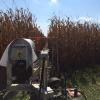Description
Open-path Fourier transform infrared spectroscopy (OP-FTIR) has often been used to measure hazardous or trace gases from ‘hot’ point sources (e.g., volcano, industrial or agricultural facilities) but seldom used to measure greenhouse gases (GHGs) from field-scale sources (e.g., agricultural soils). Closed-path mid-IR laser-based N2O, nondispersive-IR CO2 analysers, and OP-FTIR were used to measure concentrations of N2O and CO2 at a maize cropping system during 9-19 June 2014. To measure N2O/CO2 concentrations accurately, we developed a quantitative method of N2O/CO2 analysis that minimized interferences from diurnal changes of humidity and temperature. Two chemometric multivariate models: classical least squares (CLS) and partial least squares (PLS), were developed. This study evaluated various methods to generate the single beam background spectra, and different spectral regions for determining N2O/CO2 concentrations from OP-FTIR spectra. A standard extractive method was used to measure the ‘actual’ path-averaged concentrations along an OP-FTIR optical path in situ, as a benchmark to assess the feasibilities of these quantitative methods. Within an absolute humidity range of 5,000-20,000 ppmv and a temperature range of 10-35 °C, we found that the CLS model underestimated N2O concentrations (bias = -4.9±3.1 %) calculated from OP-FTIR spectra, and the PLS model improved the accuracy of calculated N2O concentrations (bias = 1.4±2.3 %). The bias of calculated CO2 concentrations was -1.0±2.8 % using the CLS model. These methods suggested that environmental variables potentially lead to biases in N2O/CO2 estimations from OP-FTIR spectra and may help OP-FTIR users avoid dependency on extractive methods of calibrations.
These data refer to figures 2, 5, 6, and 7 of Lin, C.-H., Johnston, C. T., Grant, R. H., & Heber, A. J. (2018). Application of Open Path Fourier Transform Infrared Spectroscopy (OP-FTIR) to Measure Greenhouse Gas Concentrations from Agricultural Soils. Atmospheric Measurement Techniques Discussions, 1–22. doi:10.5194/amt-2018-373.
Cite this work
Researchers should cite this work as follows:
- Lin, C.; Johnston, C.; Grant, R. H.; Heber, A. (2019). Application of Open Path Fourier Transform Infrared Spectroscopy (OP-FTIR) to Measure Greenhouse Gas Concentrations from Agricultural Fields. Purdue University Research Repository. doi:10.4231/06W5-J904
